Ever gazed at a stunning piece of pine furniture and wondered about its radiant finish? Could that secret be tung oil? Let’s explore together!
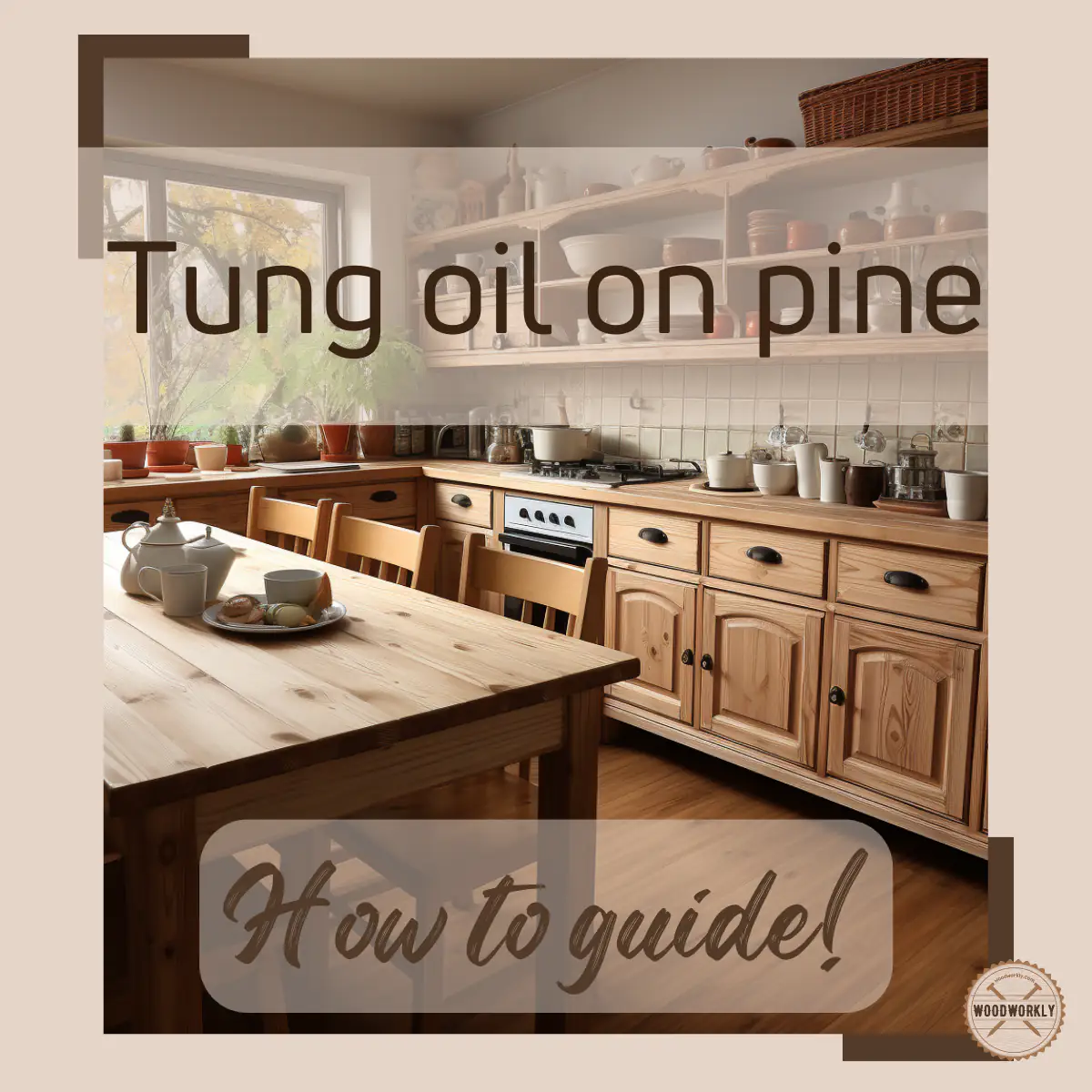
Tung oil, often referred to as “China Wood Oil,” is derived from the seeds of the Tung tree.
This natural drying oil has been used for centuries to protect and beautify wood.
The unique properties of tung oil penetrate deeply into the wood grain, enhancing the natural patterns and adding a warm glow.
Pine is a softwood that is slightly difficult to finish due to the unevenly dense grain pattern.
Therefore, when I was working with pine, I was curious about finishing pine furniture with tung oil.
So, I did some research, and here’s what I’ve found about, using tung oil on pine,
Yes, you can use tung oil on pine with no issue. Tung oil gives pine a glow and a natural shining look. Tung oil makes a protective layer that keeps pine from cracking while protecting against moisture. Apply tung oil liberally to the pinewood surface and let it dry properly.
But there’s more to know about using and applying tung oil on pine.

So, in this article, I’ll explore whether can you use tung oil on pine and how to apply tung oil on pine properly.
Furthermore, I’ll answer some frequently asked questions as well.
So, let’s keep going!

Can You Use Tung Oil on Pine?
Yes, Tung oil works perfectly on pine. It gives deep dark color to the pine wood with a wet fresh look that enhances the natural beauty of the pine wood.
Tung oil penetrates deeply into the pine wood fibers and makes them saturated, and it is got nice reflection to it and brings out the pine wood grain.
Tung oil hardens on the pine wood surface upon exposure to atmospheric oxygen and makes a protective layer on top of the surface.
This protective layer occurs because of the polymerization reaction between the oxygen and tung oil.
The protective layer keeps pine wood from cracking and adds extra protection against moisture.
Therefore, pine furniture or woodwork that tung oil has been applied, can be kept in both indoor and outdoor environments.
Tung oil is mostly used for,
- Pine furniture
- Pine panels
- Window frames
- Cabinets
- Flooring
As you can see tung oil can use in almost any kind of pine woodwork.
It works great on pine while turning wood into nice and fresh with extra protection from the outside world.
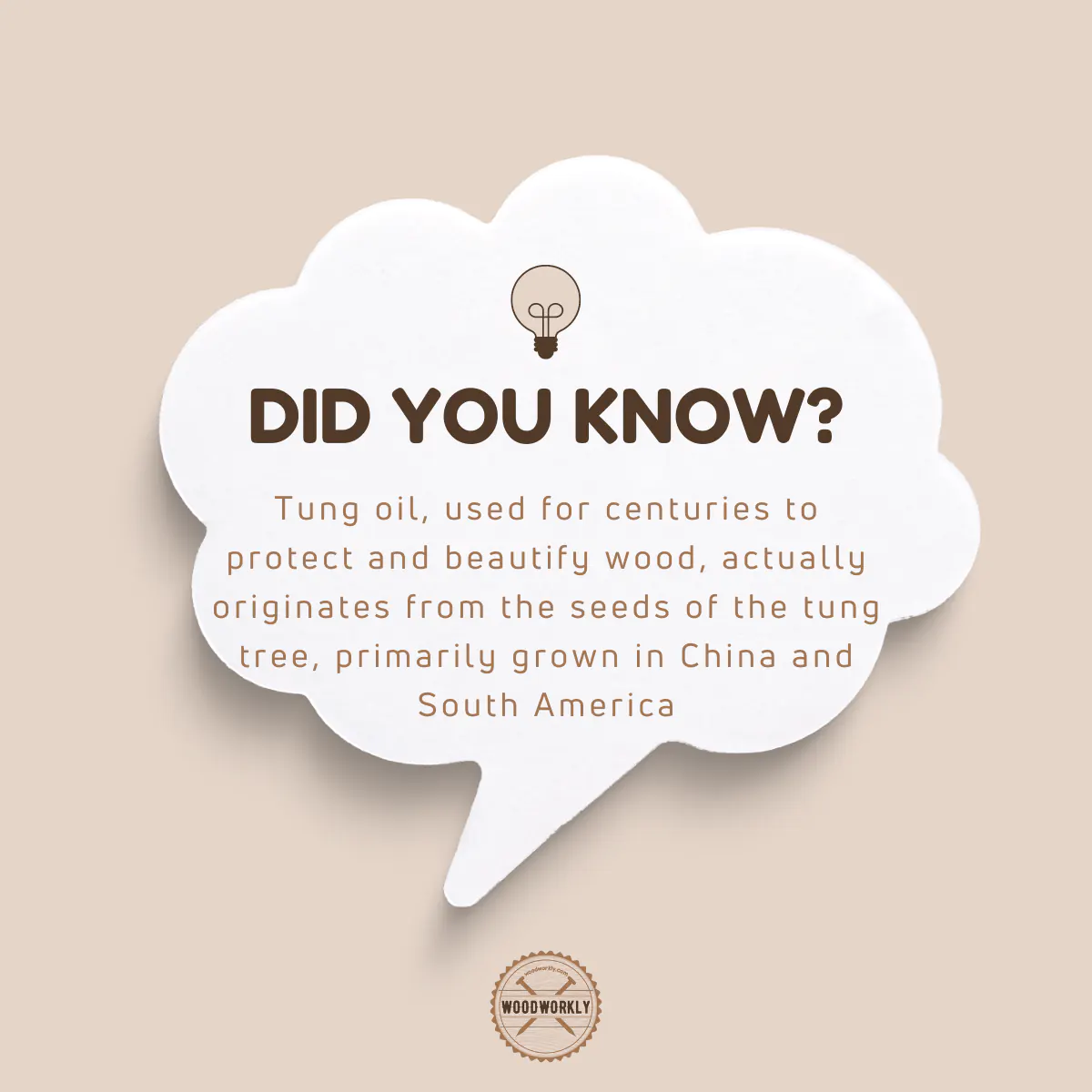
Advantages Of Using Tung Oil on Pine
- Tung oil is food safe. Therefore, you can use tung oil for kitchen utensils made of pine.
- Tung oil is non-toxic and able to use on children’s toys
- Durable oil
- Waterproof oil
- Enhance the natural look of pine wood
- Eco friendly
- Protect wood from cracking
- Easy to apply
As you can see using tung oil on pine is not a thing should worry about. They’re so compatible and able to achieve excellent results as you wish.
So, let’s see how to apply tung oil on pine properly without making any mistakes.
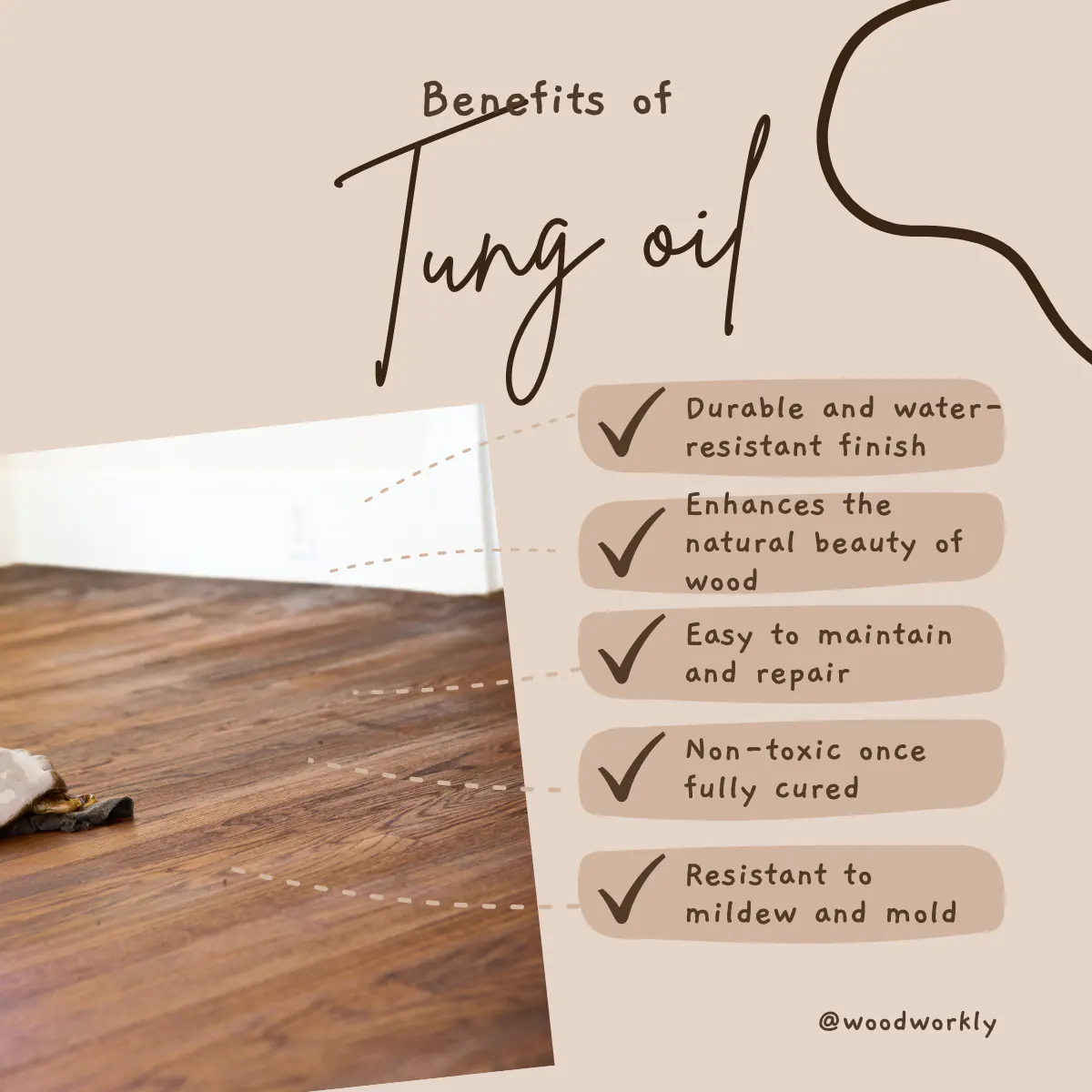
How To Apply Tung Oil on Pine?
Applying tung oil on pine is easy when you follow the right procedure. Pine is a porous wood that allows tung oil to pass through its wood fibers.
It gives an amazing finish that looks great on pine.
There’re main two methods of applying tung oil on pine. They are,
- Apply tung oil using a bristle brush
- Spray tung oil using a spray gun
The best and easiest method of applying tung oil on pine is applying using a bristle brush which we discuss further.
Here’re the essentials you need to arrange before the application process.
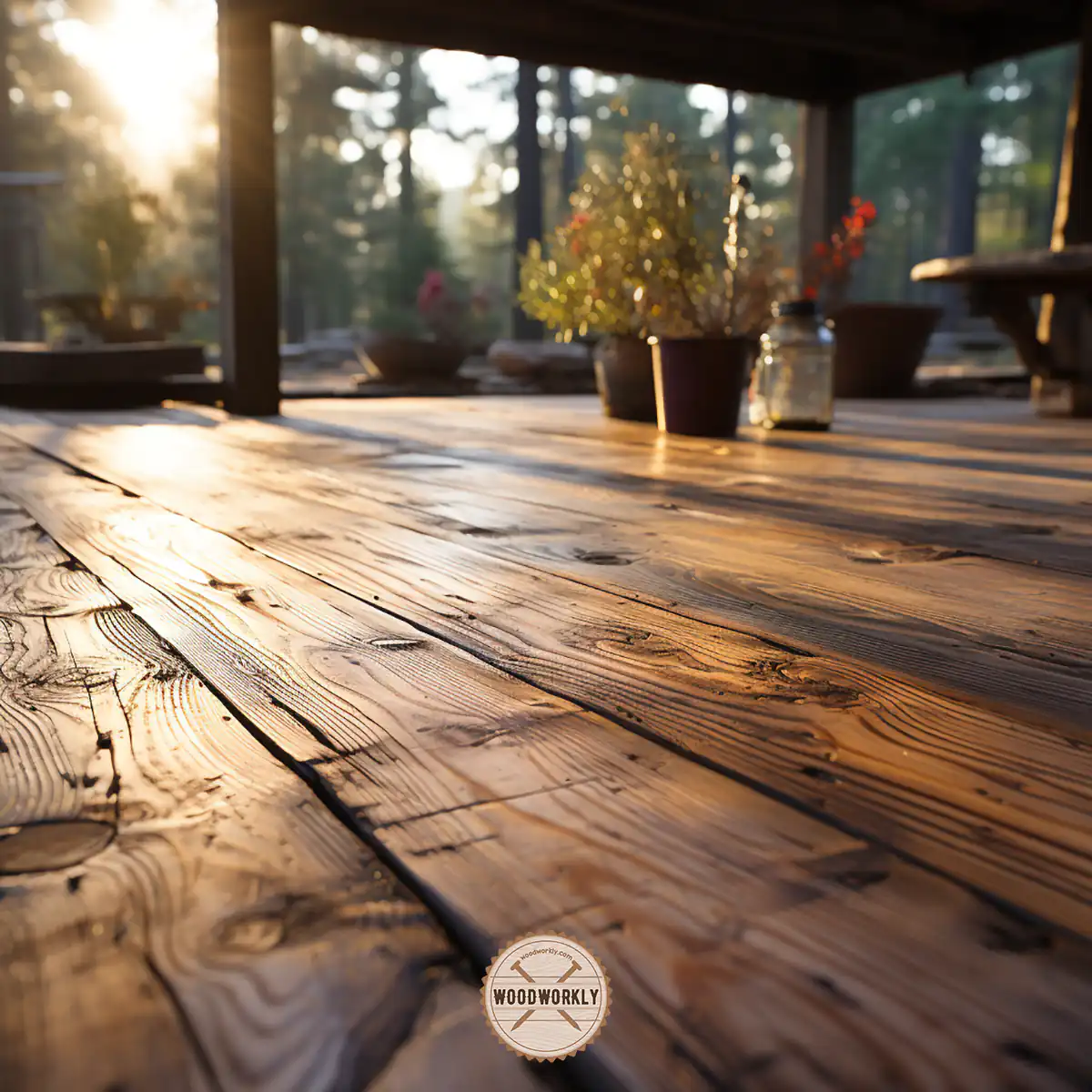
The Supplies You Will Need
- Tung oil can (Pure or dark)
- Mineral spirit
- Bristle brush or sponge brush
- Lint-free rags
- Sandpapers (120 grit, 150 grit, and 220 grit)
- Latex gloves
- Abrasive finishing pads
- Tack cloths
- Glass jar with plastic stick or stirrer
Gather the above tools and materials from quality manufacturers and get ready to use tung oil on pine.
Procedure Of Applying Tung Oil on Pine
- Prepare the pine wood surface
- Thin the tung oil
- Apply first coat
- Let it dry and light sanding
- Apply more coats
- Let the oil dry and cure properly
So, let’s discuss each of the above steps separately to get a deep knowledge about applying tung oil on pine.
1. Prepare The Pine Wood Surface
The Pine wood surface needs to be cleaned and ready to accept the tung oil.
Otherwise, tung coats can be contaminated because of dust and debris. Therefore, surface preparation is a must before wood finishing.
First of all, check if there is any existing coat or residue on the pine wood surface. Because tung oil works better under than over previous finishers.
Sand the entire pine wood surface to remove the exciting finish and make the surface clean and smooth.
If the pinewood is raw and hasn’t been touched with any kind of finisher before, clean the whole surface with a tack cloth to remove dust, contaminants, debris, grease, dirt, and oil on the surface.
Better to apply Tri-sodium phosphate for the residues that are difficult to remove with a tack cloth.
It is so much easy for tung oil to gain access to the pinewood fibers when the surface is clean.
Oil can easily penetrate through the pinewood fibers and make them saturated.
After cleaning the wood properly, sand the entire surface with 120 grits, 150 grits, and 220 grits sandpapers accordingly.
Sanding will make the surface super smooth and ready to accept the tung oil.
Then clean the sawdust with a damp cloth or vacuum and you’re done with surface preparation.
Tips:
By wetting the wood before sanding it with 220 grit sandpaper, you’ll be able to raise the wood grain. Because the raised wood grain of pine wood has better acceptance for tung oil.
Use a sprayer to wet the surface, let it dry, and then go for the sanding with 220 grit sandpaper.
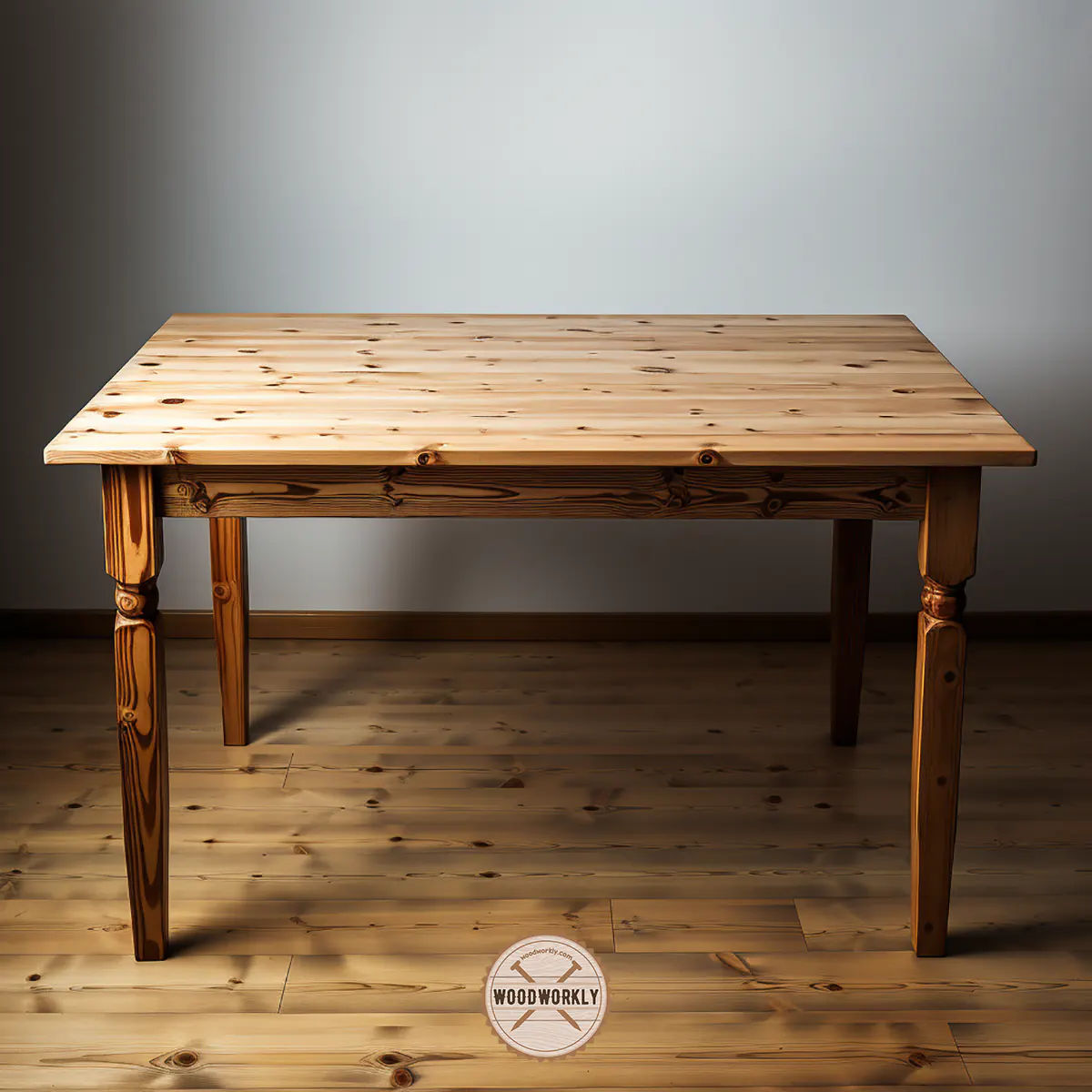
2. Thin The Oil
Thinned tung oil works better on pine wood surfaces than pure tung oil. Usually, pinewood has very narrow porous openings.
Therefore, thinned fluids pass more easily through wood fibers than thick ones. Thinned tung oil increases the absorption rate of tung oil on pine.
To thin the tung oil, open the tung oil can and pour a sufficient amount of oil into the glass jar.
Then add an equal amount of mineral spirit to it and mix them finely.
Never do the mixing vigorously because it is so hard to remove trapped air bubbles and it can be a serious issue if tung oil is applied on the wood surface with trapped air bubbles.
As you can see, every step you take when finishing pine with tung oil is so critical.
Tip:
When you’re purchasing mineral spirit to thin tung oil, never buy any mineral spirit products that are marked as green or eco-friendly because they’ll contaminate the tung oil solution. General mineral spirit is the best.
3. Apply the First Coat of Tung Oil on Pine
Dip the bristle brush or soak the sponge brush in the thinned tung oil and apply the very first coat of tung oil on the pine wood surface.
Apply tung oil evenly, uniformly, and generously throughout the whole pine wood surface with even pressure without missing any spots.
Apply along the direction of the wood grain to avoid getting uneven blotches or streaks.
The difference between tung oil and varnish is, that varnish sits on the wood surface while tung oil penetrates through the wood fibers and makes them saturated.
As a result of that tung oil is able to keep the wood from cracking as an added advantage.
After applying the first coat of tung you should get a wet look surface that isn’t puddled. Puddled surfaces can be a reason for surface blotchiness.
Therefore, wipe off puddled areas immediately with a damp cloth before they settle in.
Within the first 30 minutes of applying tung oil on pine, the wood fibers will be saturated and you can wipe the excess oils and bubbles during that time.
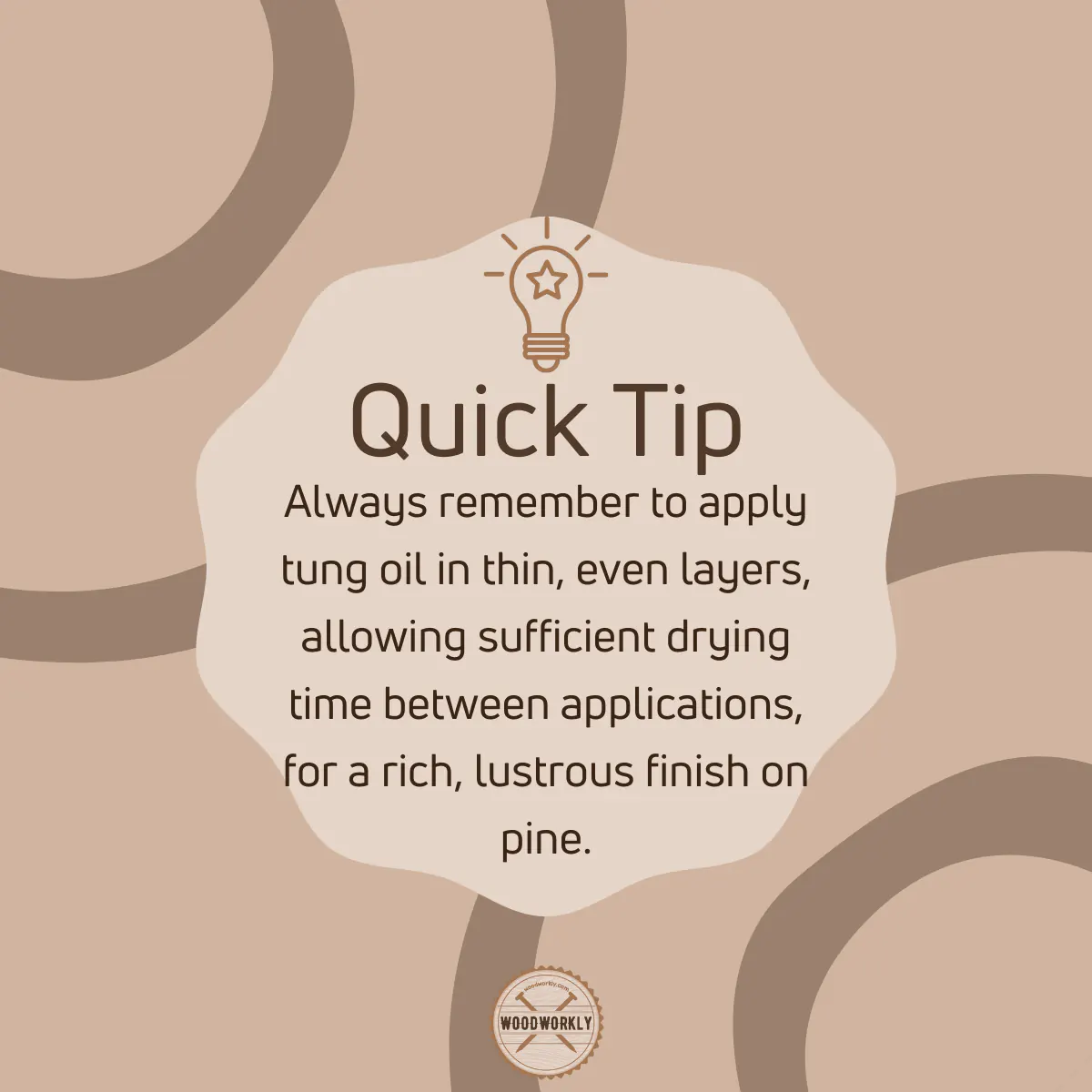
4. Let It Dry and Sand the Surface
After the application of the first coat of tung oil on pine, let it dry for around 6 hours before stepping into the next coat.
Usually, after the first 45 minutes of applying the first coat, the pine fiber cells are well saturated and significantly dry.
But for another round of tung oil, the first tung coat should dry completely from both inside and outside. This is why keeping it for 6 hours is recommended.
After 6 hours, sand the entire surface with an abrasive finishing pad to knock off dust nibs.
Abrasive pads are better than sandpapers to sand a finished surface because they don’t clog up like sandpapers.
Also, you can wash and re-use them for a long time.
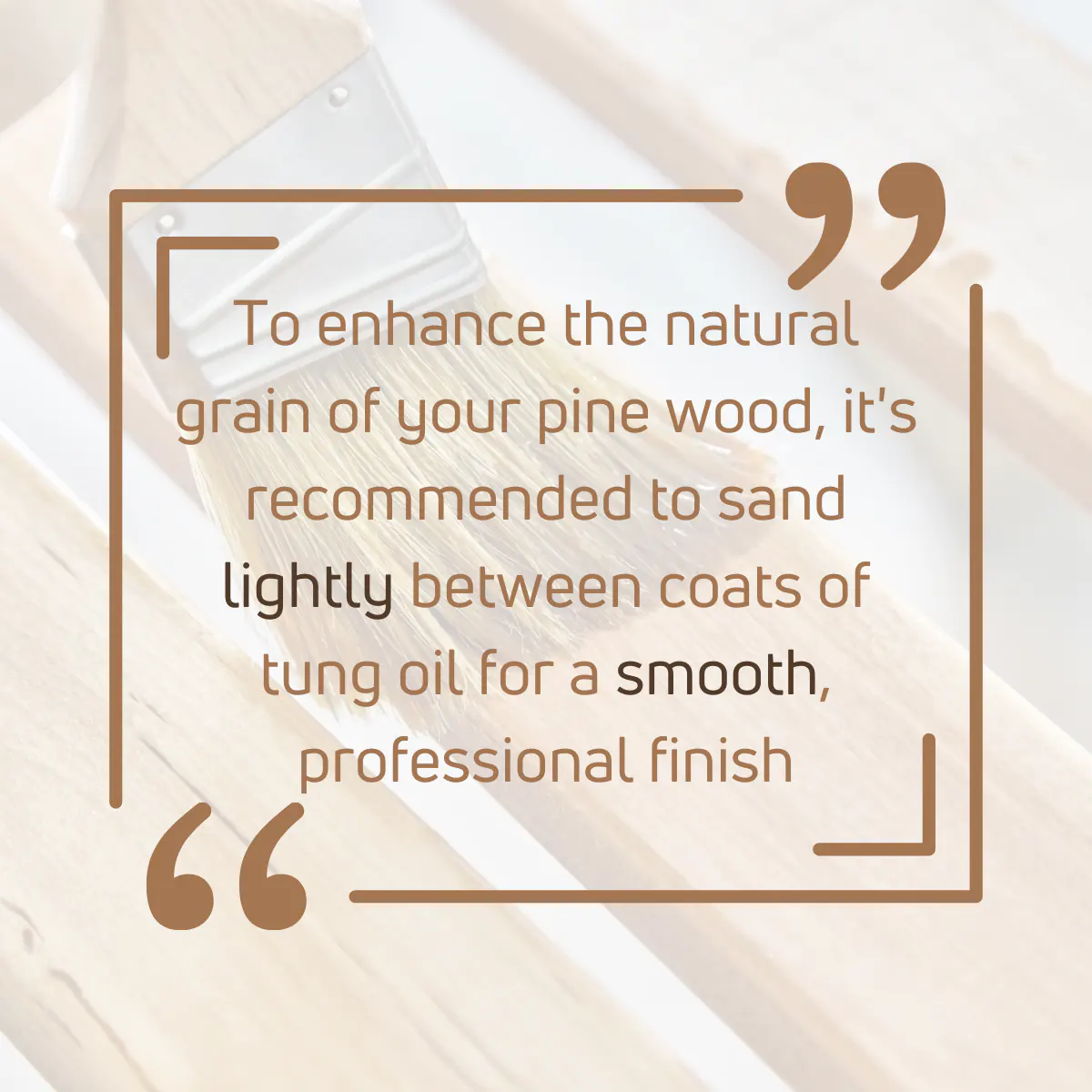
5. Apply More Coats of Tung Oil on Pine
Before applying the second coat of tung oil, wet sanding is recommended with 220 grit sandpaper.
This will make pine pores fine and boost the natural contrast of the wood.
Make sure to sand so lightly without affecting the first coat.
Just a few swipes over the entire pine wood surface are enough. Rinse the sponge with mineral spirit before using it for the wet sanding.
Once you’re done with wet sanding, wipe off the excess and let it dry. Then apply the second coat of tung oil just like the method you followed in the first coat.
Likewise, repeat the same procedure for about a minimum of 5 – 8 coats of tung oil until you get to the point where you want. As soon as you pass the 5th coat of tung oil you’ll get to notice a surprising difference in the result.
The last two coats of tung oil don’t need wet sanding.
The application time of tung oil is about 10 – 15 minutes.
Tips:
- After each application, make sure to wipe unabsorbed tung oil with a clean rag. This will increase the efficiency of the curing process because thin layers of tung oil cure faster than thick ones.
- Around the third coat of tung oil, you’ll probably notice some dull areas that didn’t take the oil well. That’s common when working with pine wood. After another 2 – 3 coats, it’ll be back to normal.
6. Let the Oil Dry and Cure Completely
Between each coat of tung oil, a minimum of 6 hours of drying time is recommended.
Each coat follows the same procedure of application, wipe on, wet sand, wipe off, let it dry, scuff it and repeat.
Drying is important between each coat to absorb the oil evenly into the pine wood.
- The drying time of tung oil on Pine is 6 hours.
- The curing time of tung oil on pine is 14 days.
After applying the final coat of tung oil, let the wood for 14 days to cure properly.
I know you’re probably wondering why it takes so much time to cure the pine wood. Yes, it does.
Because oil finishers cure more slowly than the regular ones. During the 14 days of curing, you’ll get a nice, polished look in pine wood.
Curing and drying tung oil are totally different tasks. After 6 hours of drying, you can touch the pine wood surface and it doesn’t feel sticky or tacky.
But after a couple of weeks, it is cured to a very hard and stabilized state. Therefore, 14 days of curing is a must which will result in great outcomes.
That’s all about how to apply tung oil on pine without making any errors. This is the most simple and accurate method you can follow.
After applying the oil, make sure to store it properly to avoid tung oil from getting bad.
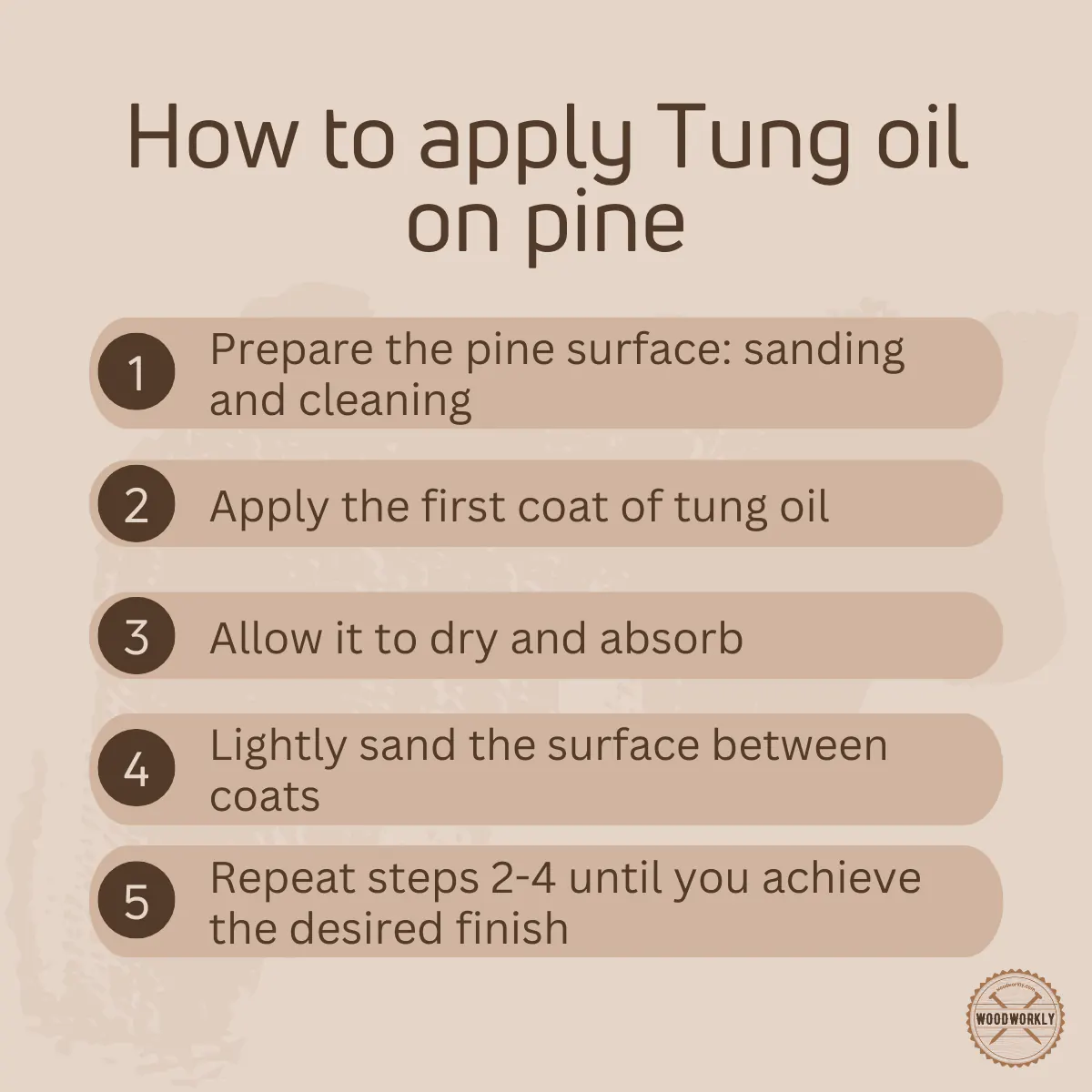
How Many Coats of Tung Oil on Pine?
Apply a minimum of 5 coats of tung oil on pine. 5 to 8 coats of tung oil are ideal to gain the best results with a nice appearance and protective layer.
Drying between each coat and curing for around 14 days is essential to receive the best from tung oil.
Can You Use Tung Oil on Exterior Pine?
Yes, tung oil can be used to treat exterior pine furniture and woodworks. Make sure to apply a minimum of 5 – 6 coats of tung oil to make it waterproof and get protected it from the outside elements.
After applying thin coats of tung oil, your pine wood furniture or woodwork cannot access the outside world.
Therefore, you can simply place your pine furniture anywhere you want without considering much about the environment. But regular maintenance is a must.
What Is the Best Tung Oil to Use on Pine?
- Minwax tung oil finish.
- Hope tung oil.
- Cabot’s tung oil.
- Real Milk paints dark tung oil.
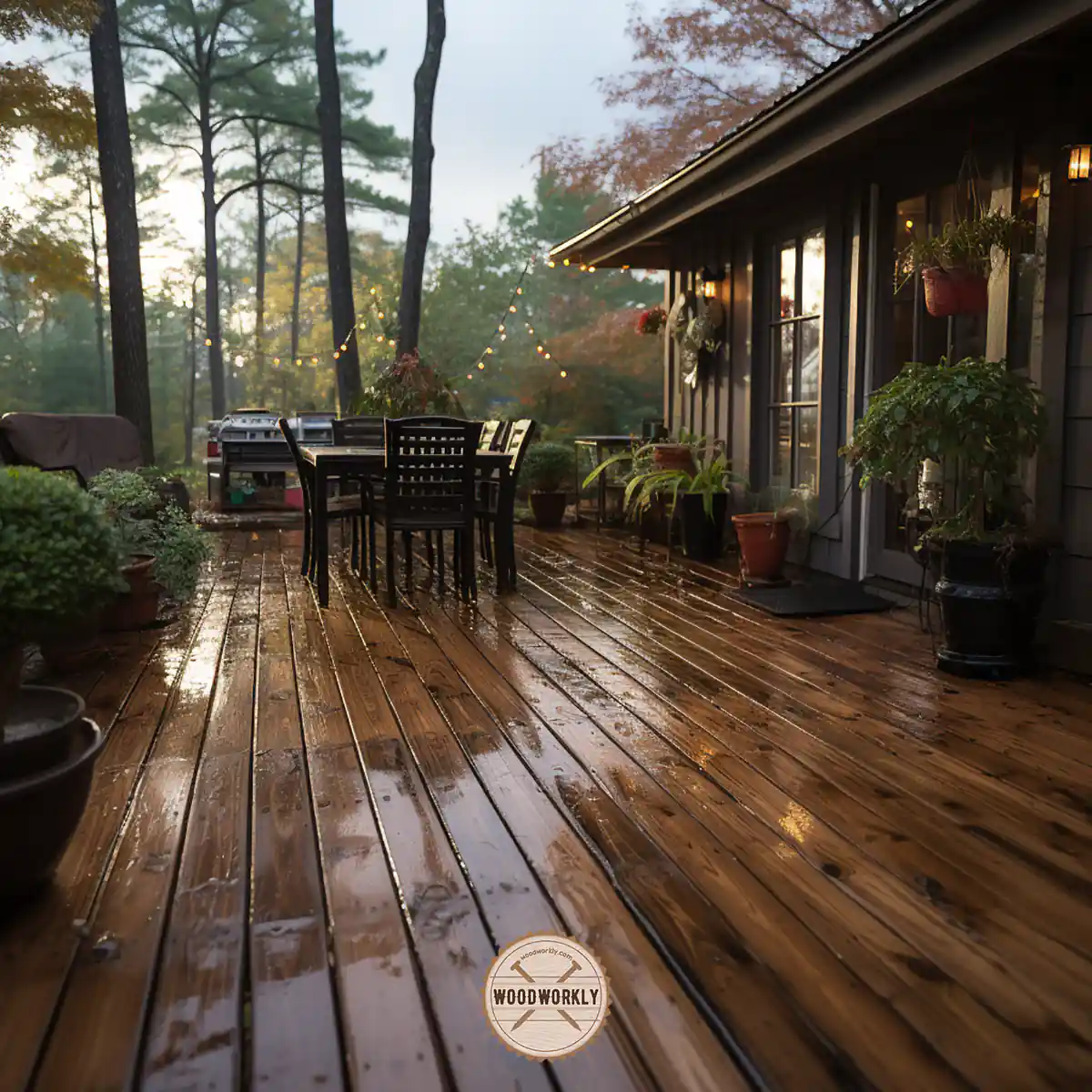
Can You Apply Tung Oil On Stained Pine?
Yes, you can apply tung oil on pine once the surface is fully dried and cured.
The most significant advantage of using tung oil over stained pine is its ability to enhance the color and grain of the wood.
It adds a glossy sheen that emphasizes the stain’s depth and brings out the rich tones of the pine wood.
Even if you’re using a darker stain, the tung oil can add a level of luster to the pine that can make the color seem even more deep and vibrant.
It’s like adding a layer of varnish, but without the artificial, plastic-like finish that varnish often imparts.
Read to know whether Tung oil darken the wood, especially when it is applied over stain.
Tips for Using Tung Oil on Pine
Working with pine and tung oil can be a delightful experience if you know the right tricks of the trade.
Having personally restored and refinished many pine pieces over the years, I’ve compiled some invaluable tips to help you get the best results when using tung oil on pine.
Tip 1: Understand Your Material
Before you start, it’s essential to understand the nature of pine wood.
Pine is a soft, porous wood, which means it tends to absorb the oil differently across the surface.
Grain areas will soak up more oil, while knots and harder areas will absorb less. Knowing this can help you ensure a more even application.
Tip 2: Prepping the Pine
Good preparation is key. Pine is often covered in a layer of resin that can interfere with the absorption of the oil.
Before you start, clean the surface with a suitable solvent, like mineral spirits, to remove any resin or old finish.
Next, sand the surface lightly with fine-grit sandpaper (220 grit is often ideal) to create a smooth surface and open up the pores of the wood.
Always sand in the direction of the grain to avoid scratches.
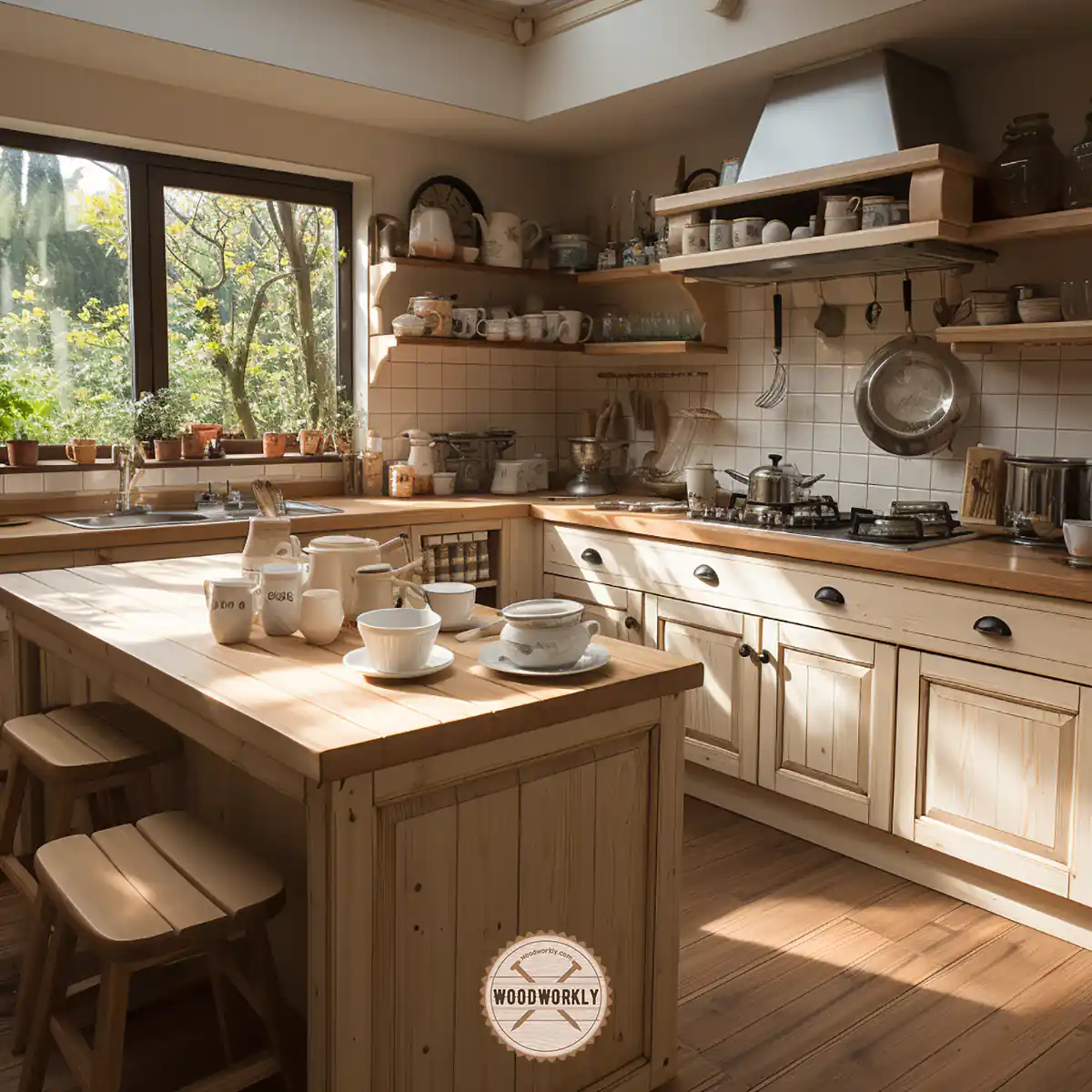
Tip 3: Thin the Tung Oil
Tung oil can be quite thick, which makes it more difficult to apply and absorb. For the first coat, it’s helpful to thin the oil with a solvent like mineral spirits.
A 50:50 mix can work well.
This thinned oil will penetrate deeper into the wood and act as a great sealer.
Tip 4: Apply with a Lint-Free Cloth
Use a lint-free cloth to apply the tung oil. Dip the cloth in the oil and rub it onto the wood, following the grain.
This method helps ensure an even distribution of oil and prevents excess oil from pooling on the surface.
My Experience with Thinning Tung Oil
When I first started using tung oil, I made the rookie mistake of applying it straight from the can onto the wood.
The oil was thick, and it didn’t spread evenly. Some areas were too shiny, while others looked dull.
It was then that a friend who was a professional woodworker gave me the tip about thinning the oil for the first coat.
What a difference it made! The thinned oil was easier to work with, it absorbed better, and it gave a much more even, natural finish.
Tip 5: Let it Dry and Repeat
Once you’ve applied a coat, let it dry. It can take 24-48 hours, depending on the humidity and temperature of your workspace.
After it’s dry, lightly sand the surface with a very fine grit sandpaper (320 or higher), wipe off the dust, and apply the next coat.
Repeat this process until you’re satisfied with the finish – typically, three to four coats should do the trick.
Tip 6: Maintenance is Key
Remember, maintenance is essential. Over time, the finish might wear off, especially on frequently used items like tables or chairs.
To keep your pine looking its best, reapply a fresh coat of tung oil every year or so.
Using tung oil on pine can truly elevate your wood projects, making them stand out with a rich, natural glow.
It’s all about understanding the characteristics of your material, preparing it well, and being patient with the process.
Congrats folks! now you know all about applying tung oil on pine.
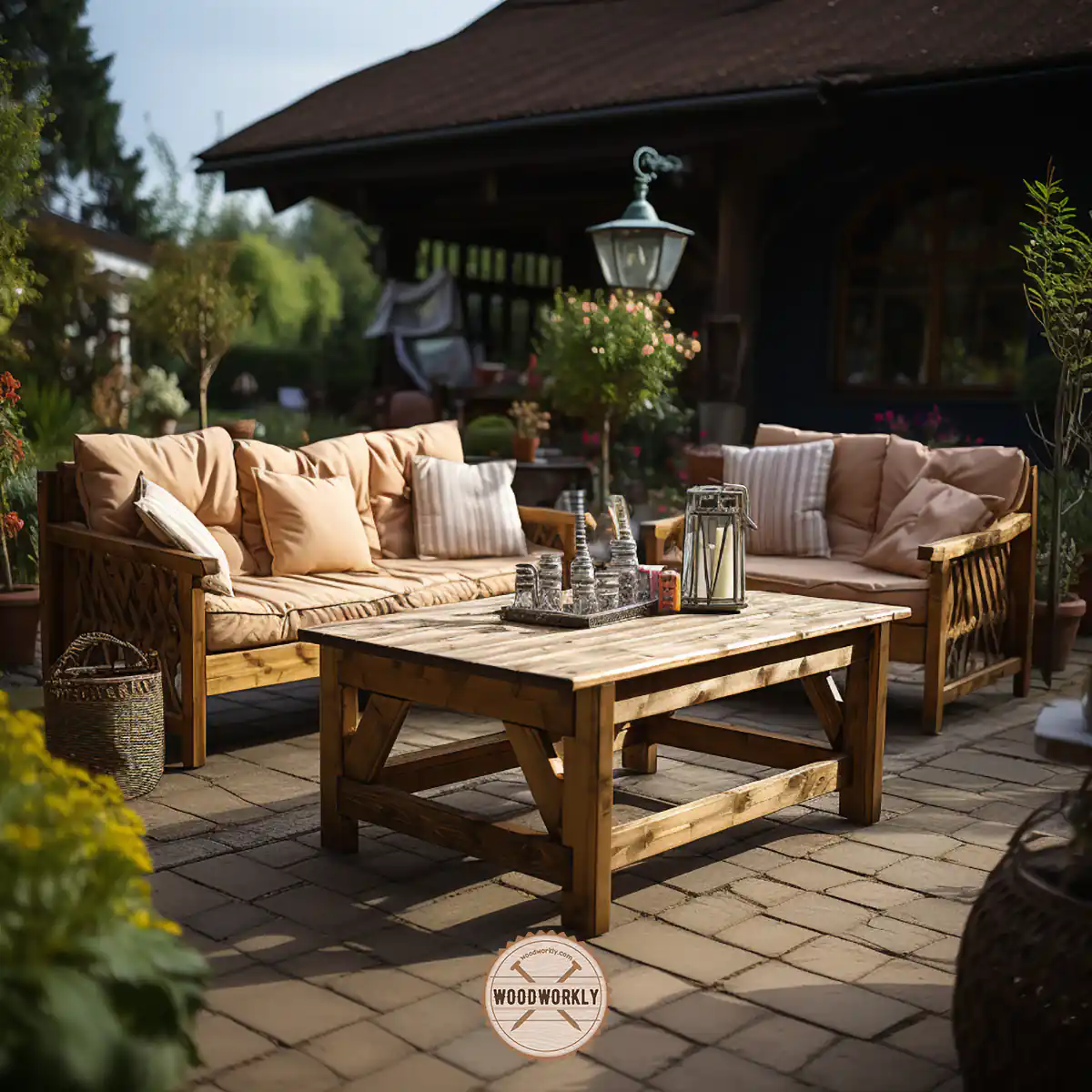
So, let’s answer some frequently asked questions.
FAQs
How long does it take for tung oil to dry on pine?
Tung oil typically takes between 24 to 48 hours to dry fully, although this can vary depending on factors like humidity, temperature, and the thickness of the applied coat.
Do I need to thin tung oil before applying it to pine?
For the initial coat, it can be beneficial to thin tung oil with a solvent such as mineral spirits. This allows the oil to penetrate deeper into the wood, providing a more even and lasting finish.
Can I use tung oil on pine furniture?
Yes! Tung oil is an excellent choice for pine furniture as it enhances the wood’s natural grain and provides a durable, water-resistant finish.
Is maintenance required after applying tung oil on pine?
Yes, periodic maintenance is necessary. For high-use items, it’s recommended to reapply a fresh coat of tung oil every year or so to keep the finish looking its best.
Did I cover all you wanted to know about: Tung Oil On Pine?
In this article, I have deeply discussed about can you use tung oil on pine and how to apply tung oil on pine without making any mistakes.
The procedure that we talked about above is the most popular method among woodworkers.
Using tung oil on pine enhances the wood’s natural grain, providing a lustrous, water-resistant finish. The process involves applying multiple coats of oil, allowing each to dry, lightly sanding between applications. Tung oil can be used on both stained and unstained pine, with maintenance needed over time.
Tung oil gives an excellent finish to pine. It will enhance the white pale-yellow color of pine to a rich color while protecting the natural grain of the wood.
Because of the protective layer, pine wood is able to use in harsh environments.
Furthermore, I’ve answered some frequently asked questions about using tung oil on pine.
Hope you have gained good knowledge about using tung oil on pine with the most simple and accurate procedure.
Now grab a piece of pinewood and practice the things you have learned in this article to get the ideal finish before moving on to the big projects. Have fun in wood finishing!